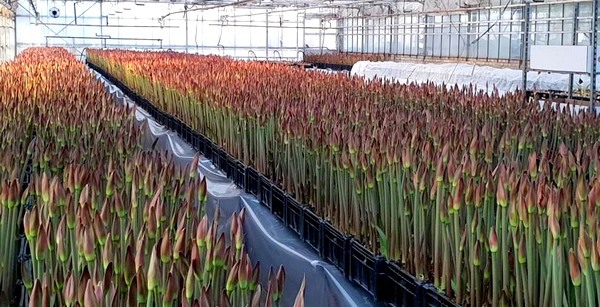 "Since 1988 we have been breeding Amaryllis varieties whose bulbs can be grown outside,” says Ruud Berbee of Park Amaryllis. “Now we have a range available that could revolutionize Amaryllis cultivation, because the product can be grown much more sustainably. Compared to conventional cultivation in the greenhouse, only 1/10 of the usual amount of energy is needed per bulb."
"Since 1988 we have been breeding Amaryllis varieties whose bulbs can be grown outside,” says Ruud Berbee of Park Amaryllis. “Now we have a range available that could revolutionize Amaryllis cultivation, because the product can be grown much more sustainably. Compared to conventional cultivation in the greenhouse, only 1/10 of the usual amount of energy is needed per bulb."
Hippeastrum bulbs have been cultivated in greenhouses for many years in the Netherlands. Cultivation has also been taking place in Africa and Latin America. This is not optimal from a sustainability point of view. The cultivation of the current range, which is permanently stored in the greenhouses, requires a ground temperature of 22ºC, which is necessary to grow, in other words, a cubic meter of gas per bulb. Due to the transport costs, the ecological footprint of imported Amaryllis bulbs also leaves something to be desired.

A piece of history
The Ludwig Amaryllis company has been active in Amaryllis breeding since the end of the 19th century. Since then, an attractive assortment has been created with varieties in all shapes and colors. Since the 1950s, cultivation has taken off because soil heating and soil cooling can be used for the cultivation of bulbs in the greenhouse. The cultivation of bulbs (and leading on from this; flowers) is based on this. In more recent years, bulbs have also been grown in Africa and Latin America for cost reasons. The cultivation of bulbs in the greenhouse requires a high cultivation temperature (a cubic meter of gas is required per bulb) and is labour-intensive. Cultivation in Africa or Latin America has serious sustainability consequences because of the transport costs. That is why breeding amaryllis to be grown outside was started in 1988.
From 2002 Ludwig started working together with Van Der Velden (Holland Blumen Markt) in Heiloo and has incorporated its breeding there under the name Park Amaryllis. A number of Amaryllis varieties have now been released to growers who grow outside in the Netherlands. They have at least 4 enormous advantages. Only 1/10 of the amount of energy is needed per bulb. They are approved by the BKD, making worldwide export easy. The varieties are so healthy that bulb disinfection is not necessary and there is no question of high transport costs, which you normally have when importing.
Old varieties as a basis
“The Amaryllis crop originally comes from Latin America,” says Ruud Berbee. “When we started looking for varieties that could be grown outside, we got genetic material from that region. Specific to this was that it concerned varieties that flowered at great heights. Logically, those varieties have a higher cold resistance. From 1988 we started crossing and crossing again with those varieties. The breeding of bulbous plants (Amaryllis, but also tulip and hyacinth) is often a matter of patience. There are 24 years between the moment of crossing and the moment you have a commercial variety that then has to be grown into a commercial batch. Regardless, a number of Amaryllis varieties are now available. They are of equal quality as the better greenhouse varieties, but you can plant them outside in the spring and harvest them in the autumn. ”
In line with other bulbous plants
The new varieties are relatively inexpensive to cultivate and, as with daffodils, re-cultivation of faded bulbs is an option. In propagation, the same machines can be used as are already used with other bulbous plants. There are therefore conceivable combinations of winter (tulip, hyacinth) and summer crops (amaryllis, lily). In terms of quality, these varieties are certainly comparable to the traditional range and these varieties can be grown very quickly. From planting to flowering in 24 days. “The varieties are suitable for water forcing,” says Berbee. “Commercial trials have been conducted with water forcing to produce cut flowers. With these Amaryllises for flower cultivation you create an extra option for your company as a tulip grower. "
Amaryllis is a bulb flower growing in popularity. Now that the product can be produced in a much more sustainable manner, opportunities are not only emerging to make this bulb flower even more popular, but also to make it available for a longer period of the year.
Come and see!
From mid-January to the 1st week of February 2021, Park Amaryllis will have 40,000 bulbs in bloom. In the greenhouse you can see forcing and pot trials of the already introduced range, as well as all new varieties.
If you are interested in outdoor cultivation, flower cultivation, pot cultivation and / or export of the bulbs and flowers, you are very welcome to visit and admire the amaryllises in the greenhouse. Please register in advance via info@parkamaryllis.nl to make an appointment (due to corona, walk-ins are not possible this season).
For more information
Park Amaryllis
Joris van der Velden, Ruud Berbee
www.parkamaryllis.nl
